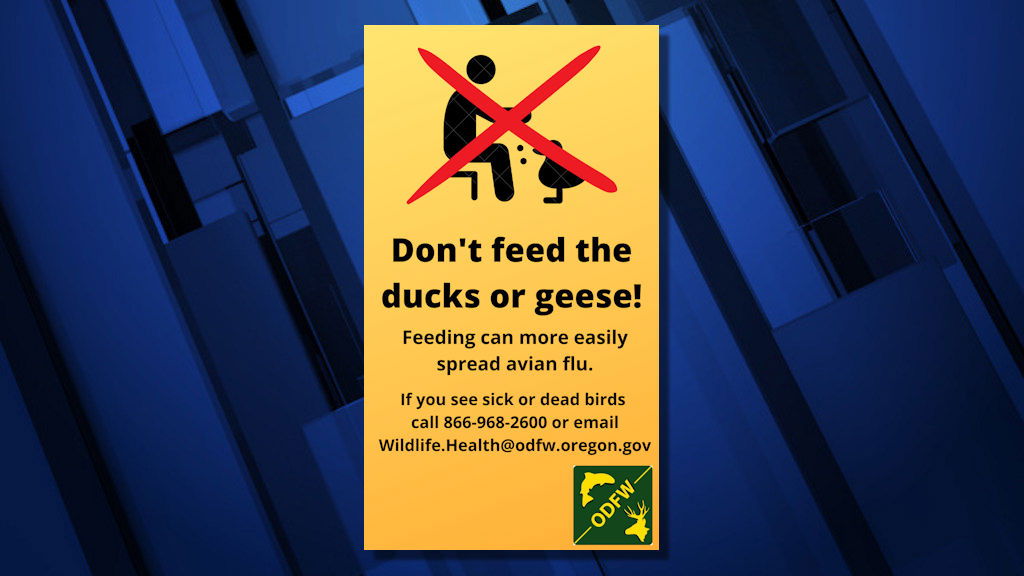Many Oregon wildlife rehabilitators are not accepting waterfowl due to avian flu risk, ODFW says

'A very sad and difficult situation'
SALEM, Ore. (KTVZ) — Many Oregon wildlife rehabilitators are currently not accepting waterfowl at present, due to the spread of avian flu in wild birds, the Oregon Department of Fish and Wildlife said Thursday.
Because waterfowl can carry the virus without showing symptoms, allowing them into rehabilitation facilities can put all the birds at the facility at risk, the agency noted.
Goslings, ducklings and adult waterfowl can all carry the virus. If you find healthy ducklings or goslings without a parent nearby, please leave them alone and allow the parents to find them, ODFW said. If you choose to interfere, they can be released at the nearest waterway.
Injured ducks and geese may be brought to an ODFW office for euthanasia. You're asked to call ahead if you are bringing in an injured duck or goose.
If you see sick or dead wild birds, ODFW says do not collect or handle them, but report the incident directly to your local ODFW office or the Wildlife Health lab at 866-968-2600 or email at Wildlife.Health@odfw.oregon.gov. ODFW said its staff will be conducting surveillance and collecting /testing sick and dead wild birds to monitor for the presence of the disease.
Portland Audubon is one of many facilities currently not accepting waterfowl.
"The risk of avian flu spreading to other birds in the wildlife rehab clinic is too high," said Wildlife Care Center manager Stephanie Herman. "We cannot risk the health of other wildlife in our care centers. We are hoping this situation is temporary and normal rehabilitation operations will return by mid-summer. Our goal is to serve all native wild animals in need of help, so this is a very sad and difficult situation."
This is the time of year when goslings, ducklings and other young birds are commonly picked up and brought into rehab centers. Well-intentioned people mistakenly think these young birds are orphaned because they may be temporarily separated from their parents.
This year, more than ever, it is important to leave wild birds in the wild to give them the best chance for survival. If you see young ducks or geese, please keep pets under tight control. Not feeding waterfowl is also especially important during this time. In addition to commonly causing nutritional issues, feeding congregates animals and results in overcrowding and increased risk of disease spread.
In Oregon, avian flu was first detected in wild birds in Canada goose goslings at Alton Baker Park in Eugene and it was also found in several red-tailed hawks in May. The current detections of the highly pathogenic virus have occurred only in Linn and Lane counties but ODFW biologists expect it to spread over the next several weeks.
This virus has been documented in more than 100 different species of wild birds worldwide since it was first detected in December 2021 in Newfoundland and Labrador, Canada. It was believed to have entered North America in an infected wild seabird or migrating waterfowl.
The virus currently circulating in Oregon and other parts of the world is very contagious among birds and can sicken and even kill many bird species, including chickens, ducks, and turkeys. Infected birds can shed avian influenza A viruses in their saliva, nasal secretions, and feces. Susceptible birds become infected when they contact the virus after it is shed by infected birds.
Wild birds that typically carry the virus include waterbirds (such as ducks, geese, swans, gulls, and terns), shorebirds (such as sandpipers), and pelicans and cormorants. Dabbling ducks (such as mallards, pintails, and wigeons) serve as reservoir hosts for avian influenza A viruses although it often does not cause disease in these species.
The disease can also infect raptors (hawks, eagles) that prey on or consume sick or dead waterfowl. The wild bird species in Oregon most at risk from this strain of virus currently appear to be all waterfowl, shorebirds, eagles and scavenging species such as crows and turkey vultures.
While very contagious and deadly for some birds, the risk to human health is low, according to the Centers for Disease Control and Prevention.